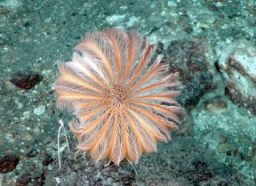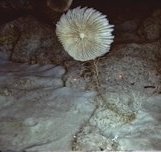Sea lilies on the run
A video shows that sea animals known as stalked crinoids do more than just creep along.
By Emily Sohn
Some animals are famous for their ability to run. Cheetahs, the fastest of all land animals, can reach speeds of 70 miles per hour. Antelope bound over hills and prairies to elude predators. Human sprinters win medals for their skill.
Other animals are known for their slowness. Sloths move only when they have to. Snails edge along at a glacial pace.
 |
|
A sea lily, or stalked crinoid, rests on the seafloor. About 5 inches (13 centimeters) across, this animal uses its feathery crown to capture food.
|
| National Oceanic and Atmospheric Administration |
Now, sea animals known as stalked crinoids have joined the ranks of those that can run.
Crinoids, also called sea lilies, are relatives of starfish and sea urchins. They live on the seafloor, and they spend most of their time standing around and catching food. Stalked crinoids look like flowers because they have feathery arms arranged in a circle on top of a long stalk.
Scientists have known for a while that some stalked crinoids move. But they usually creep along so slowly that it’s hard to tell they’re actually going anywhere. Previously, researchers aboard submersibles had noticed that crinoids appeared in different positions from dive to dive. Still, the creatures had never been measured moving faster than about 0.6 meter per hour (2 feet per hour).
 |
|
A stalked crinoid can move as fast as 140 meters per hour.
|
| Tomasz Baumiller and Charles Messing |
Now, analysis of an old video has revealed a record-breaker. In the 1990s, a submersible off Grand Bahama Island filmed a stalked crinoid moving at a speedy 140 meters per hour (459 feet per hour). The video was taken at a depth of about 400 meters (1,300 feet). It showed the creature lying on the bottom, pulling itself along with its arms. It’s the sort of crawling you might do using your elbows to pull you along.
Researchers suspect that crinoids “run” to get away from hungry predators.
What’s next—scampering mushrooms?
Going Deeper:
Milius, Susan. 2005. Great galloping crinoids: Lilylike sea animal takes a brisk walk. Science News 168(Oct. 22):261-262. Available at http://www.sciencenews.org/articles/20051022/fob6.asp .
To see a movie of a stalked crinoid in motion, click here.
You can learn more about stalked crinoids (sea lilies) and their relatives at www.ucmp.berkeley.edu/echinodermata/crinoidea.html (University of California, Berkeley), www.nova.edu/ocean/messing/crinoids/w3introduction.html (Nova Southeastern University), and tolweb.org/tree?group=Crinoidea&contgroup=Echinodermata (Tree of Life Project).







